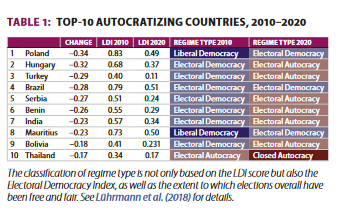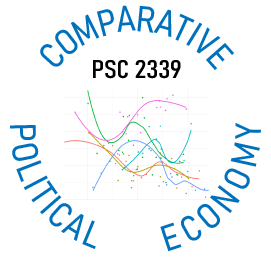
Lecture 3.1
Democratic Backsliding
What is Backsliding
Regime Types
- Democracies
- Free and fair elections
- Protection of civil liberties
- Hybrid regimes (illiberal, semi-authoritarian)
- Elections, degree of fairness in question
- More restricted civil liberties
- Authoritarian regimes
- No elections, or rigged elections
- No basic rights and liberties
Regime Type Trends
Examples

Common Mechanisms
- Constitutional amendments to enhance executive authority
- Elimination of checks and balances, reduction of accountability
- Centralization of executive power through purges
- Intimidation of media and civil society
- Elimination of political competition
- attacks on competitors
- rigged elections
Methods of Backsliding (Bormeo)
- Old Way
- Open-ended coups
- Executive coups
- Vote fraud
- New Way
- Promissory coups
- Executive aggrandizement
- Strategic harassment and manipulation
Discussion
U.S. in Comparative Perspective
- Kaufman and Haggard reading
- How has backsliding occurred in middle-income countries?
- How similar is the U.S. to these countries?
- Is electoral authoritarianism possible in the U.S.?
Some Theories of Backsliding
Leadership
- State strength and autonomy (how leaders create it)
- Role of elites in negotiating transitions, dividing power
Culture
- Civic culture
- Social capital and education
Political Institutions
- Presidential vs. parliamentary systems
- Consociationalism (for divided societies)
- Electoral institutions
- PR vs SMD
- If PR type of lists
- Party fragmentation and instability (e.g. Indonesia)
International factors
- International orgs (foreign aid, election monitoring, etc.)
- Alliances (who are your friends?)
Political Economy of Backsliding
Wealth
- Exogenous Democratization
- Rising wealth makes backsliding less likely
- “No democracy was ever subverted in a country with a per capita income higher than Argentina in 1975: $6,055” (Przeworski)
Inequality
- “Redistributivist” theory
- Democracy is more durable in egalitarian societies
- When the poor demand redistribution of elite’s wealth, elites react by “digging in their heels” because redistribution would be too drastic (Acemoglu and Robinson 2006)
- Demands for redistribution are less in societies with lower inequality and societies where assets of elites are mobile (Boix
- Competition from rising elites (Ansell and Samuels 2014)
Macroeconomic Performance
- Literature especially focused on growth and inflation (Kapstein and Converse)
- High growth rates \(\rightarrow\) less risk of backsliding
- High inflation increases risk
- Arguably more about regime stability than democracy
- Applies equally well to authoritarian regimes
- High performing autocracies likely to survive
- “Performance legitimacy”, e.g. China
Natural resource wealth
- Undermines democracy
- Promotes authoritarianism
- Focus of next week’s discussion
Exercise
Group Exercise
Pick a country to explore and an indicator
Answer these questions first:
- What is the level of democracy in your country?
- How does it rank in relation to other countries in the same region?
- What is the trend in democracy in your country?
- Is the trend similar to the region as a whole?
- Is its level of democracy predicted by modernization theory?
Then think about these questions:
- Is you country backsliding?
- What are the mechanisms of backsliding in your country?
- economic, social, institutional, etc.

Social structures